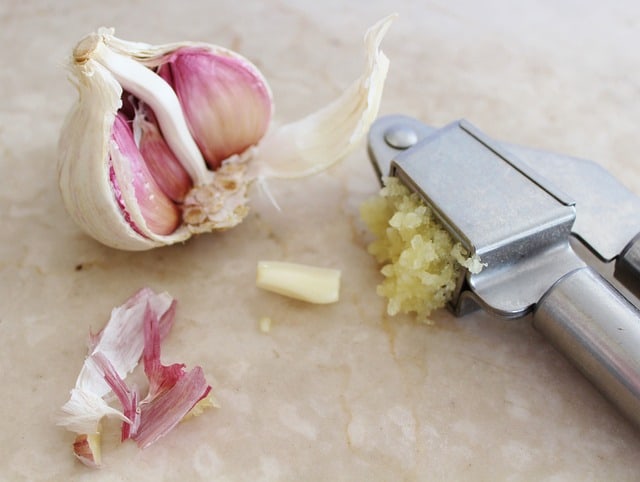Minced garlic and powdered garlic are two different forms of garlic used in cooking with each offering a different texture and benefits.
Here’s a comparison between the two and when to use each.
Minced Garlic
Process: Mincing garlic involves finely chopping fresh garlic cloves using a knife or a garlic press. You can do this yourself at home right before the garlic is required.
Flavor: Freshly minced garlic has a pungent and strong flavor. It adds a distinct garlic taste to dishes.
Aroma: Mincing garlic releases a strong aroma that can enhance the overall aroma of a dish.
Texture: Minced garlic retains its texture, providing small bits of garlic throughout the dish.
Best Applications: Mincing garlic is ideal for dishes where you want the intense flavor of fresh garlic. It works well in stir-fries, sautés, pasta sauces, marinades, and dishes that are cooked for a shorter duration.
Powdered Garlic
Process: Powdered garlic is made by dehydrating garlic cloves and grinding them into a fine powder. It’s best to buy a packet or bottle of commercially powdered garlic rather than doing the manual work yourself.
Flavor: Powdered garlic has a milder and more subtle flavor compared to fresh garlic. The flavor is slightly sweeter and less pungent.
Aroma: Powdered garlic has a less pronounced aroma compared to minced garlic.
Texture: Powdered garlic is fine and smooth, easily dissolving into dishes, sauces, or seasonings.
Best Applications: Powdered garlic is convenient to use in recipes where you want the garlic flavor without the texture. It is suitable for marinades and dry rubs, spice blends, sauces, soups, and long-cooking dishes, as the powder incorporates well and distributes evenly throughout the dish.
When to Use Minced Garlic Or Powdered Garlic
- Use minced garlic when you want the fresh, intense garlic flavor and texture to be prominent in your dish. It works well in recipes that require the aromatic and bold taste of garlic.
- Use powdered garlic when you want the convenience of a pre-ground garlic powder and a more subtle garlic flavor. It’s useful when you need a quick and easy way to incorporate garlic into dry mixes, sauces, or long-cooking recipes.
Note: While powdered garlic is a convenient option, fresh minced garlic generally provides a stronger and more authentic garlic flavor. However, both forms can be used interchangeably depending on personal preference and the specific dish you’re preparing.
Common Types of Garlic To Consider
The most common types of garlic used in food dishes are:
- Softneck Garlic: Softneck garlic is the most common and widely available type of garlic. It has a soft and pliable neck and typically produces multiple layers of cloves. It has a mild to medium flavor and a long shelf life, making it suitable for various culinary applications.
- Hardneck Garlic: Hardneck garlic has a hard, woody stem or neck and typically produces fewer but larger cloves compared to softneck varieties. It often has a more robust flavor, ranging from medium to strong. Hardneck garlic is favored by chefs and food enthusiasts for its complex and nuanced taste.
- Elephant Garlic: Despite its name, elephant garlic is not a true garlic but a member of the leek family. It has large, mild-flavored cloves and a milder taste compared to other garlic varieties. Elephant garlic is often used as a substitute when a milder garlic flavor is desired.
- Rocambole Garlic: Rocambole garlic is known for its rich and robust flavor. It has a brownish, papery skin and produces large, easy-to-peel cloves. Rocambole garlic is favored by garlic enthusiasts for its strong and complex taste profile.
- Silverskin Garlic: Silverskin garlic is a type of softneck garlic with a white papery skin. It has a long shelf life and a mild to medium flavor. Silverskin garlic is commonly used for braiding and is often found in supermarkets and grocery stores.
These are just a few examples of the most common types of garlic used in food dishes. Each variety has its own flavor profile and characteristics, allowing for different culinary experiences and applications.
Why Add Garlic To Food Dishes
Garlic is a versatile ingredient that adds various elements to food dishes in terms of flavor, texture, and aroma. Here’s a breakdown of what garlic brings to recipes:
- Flavor: Garlic adds a distinct and savory flavor to dishes. It has a pungent and slightly spicy taste with underlying sweetness when cooked. The flavor can range from mild when lightly cooked or raw, to strong and intense when sautéed or roasted.
- Aroma: Garlic releases a fragrant aroma when cooked or crushed, enhancing the overall sensory experience of a dish. The aroma is often described as rich, earthy, and aromatic.
- Depth and Complexity: Garlic contributes depth and complexity to recipes. It has umami qualities that can enhance the overall taste profile of a dish. Garlic adds layers of flavor, especially when used in combination with other ingredients and spices.
- Versatility: Garlic complements a wide range of ingredients and cuisines. It can enhance the flavors of meats, vegetables, soups, stews, sauces, marinades, and more. It’s a staple in many culinary traditions globally.
- Texture: Minced or chopped garlic adds texture to dishes, providing small bits of softness and a slight crunch when cooked. However, powdered garlic dissolves into the dish, imparting flavor without altering the texture significantly.
- Health Benefits: Garlic is known for its potential health benefits. It contains compounds that have antioxidant and antimicrobial properties, which may provide immune-boosting and heart-healthy effects. However, the concentration of these compounds may vary depending on the cooking method and duration.
Overall, garlic adds depth, richness, and complexity to food dishes. It is a versatile ingredient that can elevate the flavors of various recipes, contributing to the overall taste experience.

